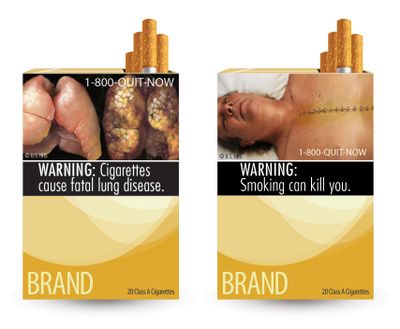Judge questions images for cigarette packages

WASHINGTON (AP) — A federal judge peppered a government lawyer with questions Wednesday expressing doubts about whether the Food and Drug Administration can force tobacco companies to post graphic images on their cigarette packages showing the health effects of smoking.
In a two-hour hearing, U.S. District Judge Richard Leon closely questioned Justice Department lawyer Mark Stern on whether the nine graphic images proposed by the FDA convey just the facts about the health risks of smoking or go beyond that into advocacy — a critical distinction in a case over free speech.
The cigarette companies sued in an effort to block the FDA from enforcing the requirement, which would go in effect a year from now.
The images include a cloud of cigarette smoke within inches of a baby’s face; a pair of healthy lungs next to the diseased lungs of a smoker and a warning that smoking causes fatal lung disease; a smoker’s stained teeth and a lip diseased by cigarettes; and a dead smoker on an autopsy table with surgical stitches in his chest and the words “Smoking can kill you.”
If the judge were to conclude the images amount to advocacy, that would make it more likely that the tobacco companies would be able to block the government’s latest move in regulating the industry.
Leon said he hopes to issue a ruling by the end of October.
Lawyers for the tobacco companies argued that the government is free to tell people how to live — through steps such as enacting smoking bans on teenagers and by requiring written, factual warnings on the sides of cigarette packages from the surgeon general about the effects of smoking.
But what the government cannot do is “conscript” the companies “into an anti-smoking brigade,” noted First Amendment lawyer Floyd Abrams told the judge.
The judge questioned Stern about why the images did not amount to advocacy. “What do you say is the line” between advocacy and fact? he asked Stern.
“This is not an ordinary product” and the images coupled with written warnings are designed to communicate the dangers to the public — including youngsters as well as adults, Stern replied.
Tobacco companies are increasingly relying on their packaging to build brand loyalty and grab consumers. It’s one of few advertising levers left to them after the government curbed their presence in magazines, billboards and TV.
In June, the FDA approved nine new warning labels that companies are to print on the entire top half of cigarette packs, front and back. The new warnings, each of which includes a number for a stop-smoking hotline, must constitute 20 percent of cigarette advertising, and marketers are to rotate use of the images.
The companies, led by R.J. Reynolds Tobacco Co. and Lorillard Tobacco Co., sued the FDA last month to block the labels. Other plaintiffs are Commonwealth Brands Inc., Liggett Group LLC and Santa Fe Natural Tobacco Company Inc.
Altria Group Inc., parent company of the nation’s largest cigarette maker, Marlboro maker Philip Morris USA, is not in the lawsuit.
The tobacco industry’s legal challenge could delay the new warning labels for years. Such a delay would likely save cigarette makers millions of dollars in lost sales and increased packaging costs.
AP Tobacco Writer Michael Felberbaum in Richmond, Va., contributed to this report.